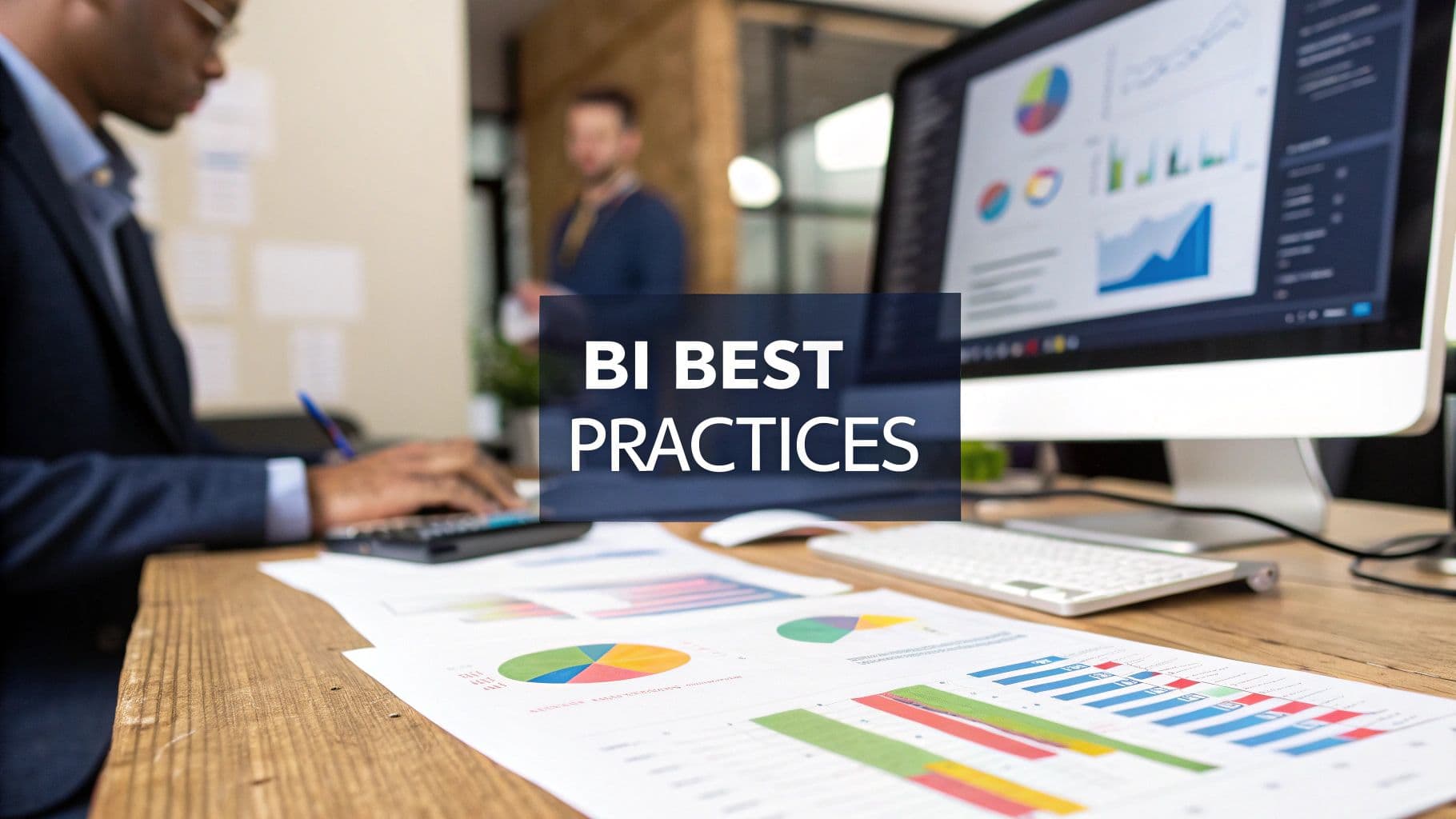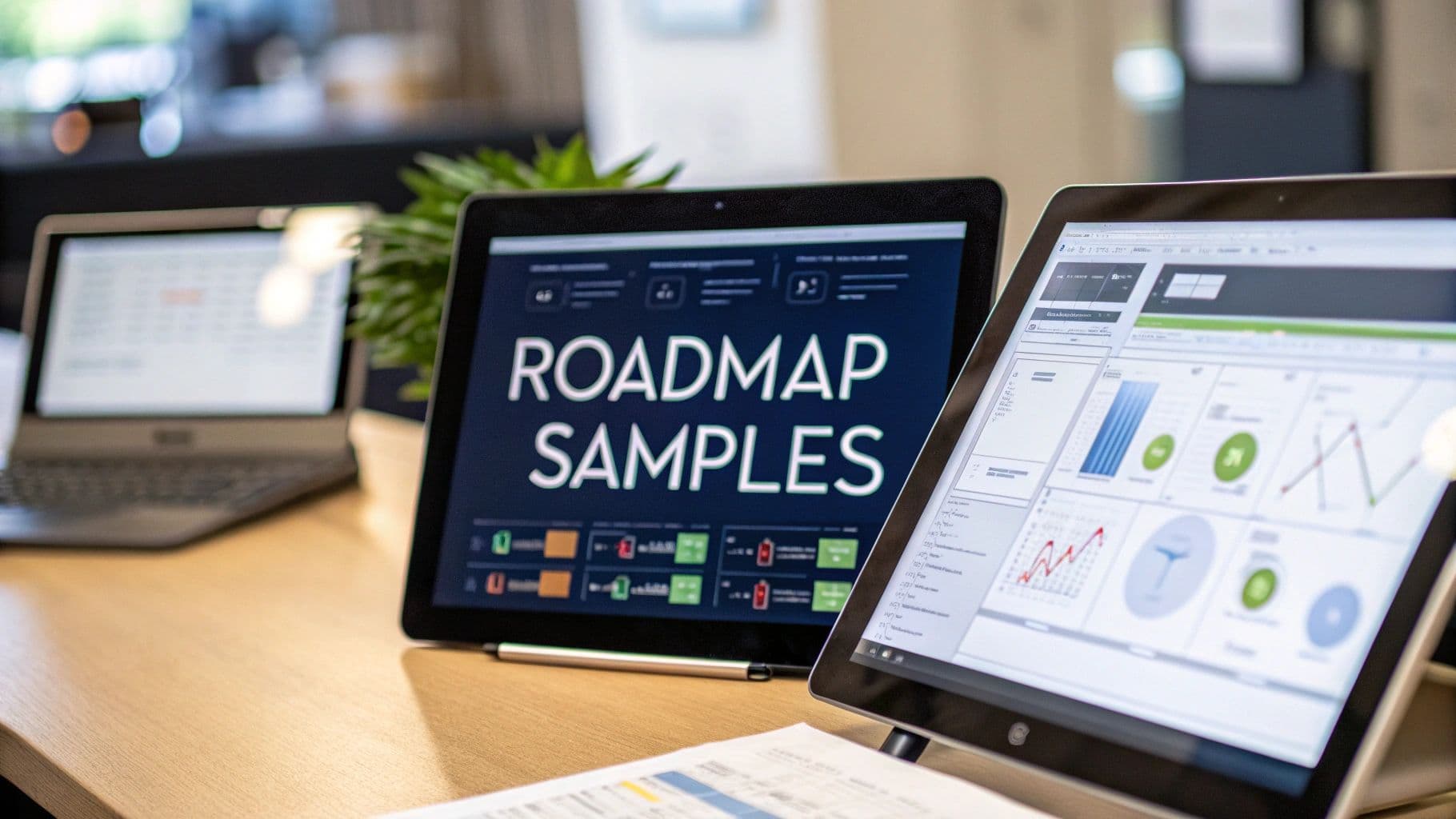9 Business Intelligence Best Practices for 2025 Success
Unlock data-driven success with our guide to business intelligence best practices. Explore 9 essential strategies for governance, analytics, and more.

In a data-saturated business environment, collecting vast amounts of information is the baseline, not the benchmark. The true competitive differentiator emerges from the ability to skillfully transform this raw data into clear, actionable insights that drive strategic growth, spark innovation, and streamline operational efficiency. Without a structured approach, organizations risk drowning in data lakes, making decisions based on flawed interpretations, or failing to capitalize on timely opportunities. Establishing a robust Business Intelligence (BI) framework is no longer a luxury for large enterprises; it is a fundamental necessity for any organization aiming to thrive.
This guide moves beyond theoretical concepts to provide a practical, actionable blueprint. We will detail nine essential business intelligence best practices designed to help you build and refine a powerful BI ecosystem. These principles are crafted for leaders and practitioners across technology-focused roles, from product managers and data analysts to CTOs and customer success teams. Following these guidelines will enable you to navigate the complexities of data governance, user enablement, and advanced analytics with confidence.
You will learn how to implement a culture of data-driven decision-making, ensuring that every team member is empowered with the right information at the right time. We will cover a comprehensive spectrum of critical topics, including:
- Establishing rigorous data governance and quality controls.
- Empowering teams with self-service analytics capabilities.
- Integrating advanced analytics and machine learning for predictive insights.
- Optimizing your BI infrastructure for performance, scalability, and agility.
By applying these proven strategies, you can move from simple data reporting to creating a dynamic, intelligent system that consistently delivers measurable business value and fosters a true data-first culture.
1. Data Governance and Quality Management
At the heart of any successful BI initiative lies a non-negotiable foundation: data governance and quality management. This practice involves creating a comprehensive framework of policies, procedures, and standards to ensure data is accurate, consistent, secure, and available. It’s the rulebook that governs how data is collected, stored, processed, and utilized, ensuring that the insights derived from it are trustworthy and reliable. Without it, even the most advanced analytics tools will produce flawed results, leading to poor business decisions.

This is a core component of business intelligence best practices because it directly impacts the integrity of every report, dashboard, and analytical model. Companies like Netflix leverage robust data governance to manage petabytes of user data, enabling their hyper-personalized recommendation engine. Similarly, financial institutions like JPMorgan Chase implement strict governance to comply with regulations while powering risk analytics.
How to Implement Data Governance
Getting started doesn't require a complete organizational overhaul. A focused, iterative approach is most effective.
- Establish Clear Ownership: Assign data stewards for critical business domains (e.g., customer, product, sales). These individuals are accountable for the quality and definition of data within their domain.
- Prioritize Critical Data: Begin by applying governance to the datasets that have the highest impact on business outcomes. For many SaaS companies, this means focusing on customer and product usage data first.
- Automate Quality Checks: Implement automated data quality monitoring tools to flag anomalies, duplicates, and inconsistencies in real-time. This proactive approach prevents bad data from contaminating your BI systems.
- Create a Data Dictionary: Document your data assets. A centralized data dictionary or business glossary defines key metrics and terms, ensuring everyone in the organization speaks the same data language. For a deeper dive into managing customer data effectively, explore these customer data integration best practices.
By establishing a strong data governance framework, you build trust in your data, reduce risks, and empower teams to make confident, data-driven decisions that propel business growth.
2. Self-Service Analytics and Democratization
The next evolution in BI maturity is empowering business users to explore data independently. Self-service analytics and data democratization shift the power from a centralized IT or data team to the frontline decision-makers. This practice involves providing intuitive, user-friendly tools that allow non-technical staff to access, analyze, and visualize data, create their own reports, and answer business questions without waiting in a queue for a specialist. When implemented correctly, it fosters a culture of data curiosity and accelerates insight-driven actions across the organization.

This is a critical component of modern business intelligence best practices because it removes bottlenecks and scales data-driven decision-making. For example, Airbnb empowers its hosts and internal teams with self-service tools to create custom analytics dashboards, driving operational improvements. Similarly, Spotify provides its playlist curators and marketing teams with self-service data exploration capabilities, enabling them to quickly understand listener behavior and content performance. This approach transforms data from a guarded resource into a shared organizational asset.
How to Implement Self-Service Analytics
A successful rollout requires a balance of empowerment and control. A structured approach ensures users are enabled, not overwhelmed.
- Provide Comprehensive Training: Equip users with the skills they need to use the tools effectively. Offer structured training programs, workshops, and on-demand resources tailored to different roles and skill levels.
- Create Curated and Certified Datasets: Don't just open the floodgates. Provide business users with access to pre-vetted, curated, and certified data marts or data models. This ensures they are working with clean, reliable data and simplifies their exploration process.
- Establish Governance Guardrails: While the goal is freedom, it shouldn't lead to chaos. Implement governance policies that define access rights, usage protocols, and data security standards within the self-service environment.
- Offer Templates and Best Practices: Kickstart user adoption by providing pre-built dashboard templates and examples of high-quality analysis. This helps users understand what's possible and provides a foundation to build upon, a strategy championed by tools like Tableau and Power BI.
By democratizing analytics, you empower teams to answer their own questions, foster innovation, and embed data into the fabric of their daily operations, creating a truly data-fluent organization.
3. Real-Time and Near-Real-Time Analytics
In today's fast-paced business environment, the ability to act on data instantly is a significant competitive advantage. This is where real-time and near-real-time analytics come in. This practice involves building systems that process and analyze data as it is generated, or with minimal delay, enabling immediate insights and rapid responses to changing conditions. It moves beyond traditional batch processing, leveraging streaming data architectures and in-memory technologies to deliver insights in seconds, not hours.

This is a critical component of modern business intelligence best practices because it empowers proactive decision-making. For example, Uber uses real-time analytics to power its dynamic pricing and match riders with available drivers instantly. Similarly, e-commerce giants like Amazon process millions of real-time events for fraud detection and personalized product recommendations, directly impacting revenue and customer experience. These capabilities are powered by technologies like Apache Kafka and Snowflake that make real-time data ingestion and processing accessible.
How to Implement Real-Time Analytics
Adopting a real-time approach requires careful planning and a focus on specific, high-value outcomes. It's about starting small and scaling strategically.
- Identify High-Impact Use Cases: Begin with business problems where speed is a critical factor, such as fraud detection, operational monitoring, or personalized customer engagement. Don't try to make everything real-time at once.
- Design for Scalability: Build your real-time data architecture with future growth in mind. Choose technologies that can handle increasing data volumes and processing demands without significant re-engineering.
- Balance Speed with Complexity: Understand the trade-offs. While real-time data is powerful, it introduces system complexity and cost. Determine if "near-real-time" (e.g., updates every few minutes) is sufficient for certain use cases.
- Monitor Performance Continuously: Real-time systems require vigilant monitoring to ensure data pipelines are healthy, latency is low, and the system is performing as expected. Set up alerts for any performance degradation.
By selectively implementing real-time analytics, organizations can respond to opportunities and threats as they happen, transforming their BI from a rear-view mirror into a forward-looking navigation system.
4. Mobile BI and Responsive Design
In today’s fast-paced business environment, decision-makers are no longer tethered to their desks. Mobile BI and responsive design address this reality by ensuring that critical business insights are accessible anytime, anywhere, on any device. This practice involves creating BI dashboards and reports that automatically adapt to various screen sizes and interaction methods, from smartphones and tablets to desktops. The goal is to provide a seamless, optimized user experience that delivers full functionality without compromise, empowering leaders to act on data at the moment of need.

This is a crucial element of modern business intelligence best practices because it transforms BI from a static, office-based activity into a dynamic, on-the-go tool. For instance, Salesforce equips its sales teams with mobile analytics to track pipeline progress and customer interactions directly from the field. Similarly, Starbucks managers use dedicated mobile BI apps to monitor real-time store performance, staffing levels, and inventory, enabling swift operational adjustments. These applications demonstrate how mobile access to data directly drives efficiency and informed action.
How to Implement Mobile BI and Responsive Design
Successfully deploying mobile BI requires a thoughtful approach that prioritizes usability and relevance for users on the move.
- Prioritize Key Metrics for Mobile Display: Mobile screens have limited real estate. Focus on displaying the most critical, high-level KPIs that support quick decision-making. Avoid cluttering the view with granular data better suited for a desktop deep dive.
- Design Thumb-Friendly Navigation: Ensure all interactive elements like filters, buttons, and drill-down menus are large enough and spaced appropriately for easy touch interaction. The user experience should feel intuitive and native to the mobile environment.
- Optimize for Various Screen Sizes: Use responsive design principles to ensure your dashboards render correctly across different devices and orientations (portrait and landscape). Leading platforms like Tableau Mobile and Power BI Mobile handle much of this automatically.
- Implement Strong Mobile Security Measures: Since sensitive data will be accessed outside the corporate network, robust security is non-negotiable. Implement multi-factor authentication (MFA), data encryption, and device management policies to protect your information.
By embracing a mobile-first mindset, you empower your entire organization with the flexibility to access and act on data wherever they are, turning insights into a constant competitive advantage.
5. Advanced Analytics and Machine Learning Integration
To elevate BI from a reactive reporting tool to a proactive strategic asset, organizations must integrate advanced analytics and machine learning (ML). This practice moves beyond descriptive analytics (what happened) to predictive (what will happen) and prescriptive (what should we do) insights. By embedding ML algorithms directly into BI platforms, businesses can forecast trends, uncover hidden patterns, and automate complex decision-making processes.
This is a critical component of modern business intelligence best practices because it unlocks future-oriented insights that provide a significant competitive advantage. For example, American Express integrates machine learning with its BI systems for real-time fraud detection, saving billions. Similarly, Walmart leverages predictive analytics for sophisticated demand forecasting, optimizing its massive supply chain and inventory management. These companies don't just look at past performance; they use data to shape future outcomes.
How to Implement Advanced Analytics
Integrating ML into your BI strategy requires a methodical approach that connects powerful algorithms with tangible business problems.
- Start with Well-Defined Use Cases: Begin with a specific, high-impact business question. Instead of a broad goal like "improve sales," focus on a precise problem like "predict which customers are at high risk of churning in the next 30 days."
- Ensure High-Quality Training Data: Machine learning models are only as good as the data they are trained on. Use the clean, governed data established in earlier steps to build accurate and reliable predictive models.
- Provide Explainable AI (XAI): For business users to trust and act on ML-driven insights, they need to understand the "why" behind a prediction. Implement XAI tools that can articulate the key factors influencing a model's output in simple terms.
- Balance Automation with Human Oversight: While ML can automate decisions, it's crucial to maintain human oversight. Use models to provide recommendations and augment human expertise, not replace it entirely, especially in strategic contexts. For a closer look at how this synergy works, discover the role of AI in product management.
By thoughtfully integrating advanced analytics, you transform your BI platform from a rear-view mirror into a GPS, providing intelligent guidance that directs your business toward its goals.
6. Cloud-First BI Strategy
A cloud-first strategy prioritizes cloud-based infrastructure and platforms for all business intelligence workloads. This modern approach moves away from traditional on-premise servers, leveraging the immense scalability, cost-effectiveness, and advanced capabilities of cloud services. It's about designing your BI ecosystem to be agile, accessible from anywhere, and ready to handle ever-increasing data volumes without massive capital expenditure on hardware.
This is a critical component of modern business intelligence best practices because it democratizes access to powerful analytics and enables organizations to innovate faster. For example, Netflix migrated its entire data infrastructure to AWS, allowing it to analyze vast streams of user interaction data to power its recommendation engine and content strategy. Similarly, Airbnb utilizes the Google Cloud Platform to manage its large-scale analytics, gaining insights into booking trends and customer behavior globally.
How to Implement a Cloud-First BI Strategy
Transitioning to the cloud requires careful planning to maximize benefits and mitigate risks. A phased, strategic approach is key to a successful implementation.
- Develop Cloud Governance Policies: Establish clear rules for data security, access control, and compliance within the cloud environment. This ensures that as you scale, your data remains secure and well-managed.
- Plan Data Migration Carefully: Start by migrating less critical workloads or creating a hybrid model. Assess data dependencies and plan the migration process in stages to minimize disruption to business operations.
- Monitor and Optimize Cloud Costs: Cloud spending can escalate quickly if not managed. Use cloud cost management tools to monitor usage, set budgets, and optimize resource allocation to ensure a strong return on investment.
- Integrate Advanced Analytics: Leverage the cloud’s native capabilities for machine learning and artificial intelligence. Beyond traditional reporting, the integration of advanced analytics, including AI for data analytics, is essential for uncovering complex patterns and generating predictive insights.
By adopting a cloud-first strategy, you create a flexible and powerful foundation for your BI initiatives, enabling your organization to adapt quickly to market changes and leverage data as a true strategic asset.
7. Data Storytelling and Visualization Excellence
Beyond raw numbers and dashboards, one of the most critical business intelligence best practices is the ability to transform data into a compelling narrative. Data storytelling and visualization excellence involves using design principles and business context to create intuitive, actionable visuals that communicate insights clearly. It's the art of turning complex datasets into stories that resonate with stakeholders, guide their understanding, and inspire action. Without this, even the most profound insights can get lost in a sea of confusing charts and tables.
This practice is essential because humans are wired to understand stories far better than spreadsheets. Companies like Spotify master this with their annual "Wrapped" campaign, which turns individual user data into a shareable, personal story of their year in music. Similarly, news organizations like The New York Times use sophisticated data storytelling to explain complex topics like election results and public health trends, making the information accessible and impactful for millions.
How to Achieve Visualization Excellence
Mastering data storytelling doesn't require a design degree. It requires empathy for your audience and a focus on clarity.
- Start with the "Why": Before choosing a chart, define the key question you are answering and the single most important message you want to convey. The visualization should serve this message above all else.
- Choose the Right Visual: Don't default to a pie chart. Select the chart type that best represents your data’s story. Use bar charts for comparisons, line charts for trends over time, and scatter plots for relationships between variables.
- Declutter and Focus: Remove anything that doesn't add value, such as unnecessary gridlines, borders, or distracting colors. Use a consistent color scheme and branding to create a professional and cohesive look that guides the viewer's eye. For those utilizing popular platforms, understanding specific Power BI best practices is crucial for unlocking data potential and achieving BI excellence.
- Test and Iterate: Share your visualizations with a few stakeholders before a wide release. Ask them what they take away from the chart. If their interpretation doesn't match your intent, refine the design until the message is crystal clear.
By weaving data into a clear and compelling narrative, you ensure that your insights are not just seen but understood and acted upon, maximizing the ROI of your BI efforts.
8. Agile BI Development and Iterative Delivery
The days of monolithic, multi-year BI projects are over. Modern business intelligence best practices champion an agile and iterative approach to development. This methodology breaks down large BI initiatives into small, manageable cycles or "sprints." Each sprint delivers a functional piece of the solution, allowing for continuous user feedback, rapid adaptation to changing requirements, and incremental value delivery. Instead of waiting months for a perfect but potentially outdated solution, stakeholders get working analytics in weeks.
This practice is essential because it aligns BI development with the fast-paced nature of modern business. It ensures that the final product truly meets user needs rather than just fulfilling an initial set of requirements that may have become obsolete. Companies like Spotify use agile BI to continuously refine their artist analytics platforms, while Adobe applies these principles to rapidly evolve their Marketing Cloud analytics. This iterative process fosters collaboration between technical teams and business users, resulting in more relevant and impactful insights.
How to Implement Agile BI
Adopting an agile mindset for BI projects fosters flexibility and accelerates time-to-value. An incremental rollout is key to a successful transition.
- Start with Small, High-Impact Projects: Begin with a clearly defined, high-value project, such as creating a sales performance dashboard for a specific team. This allows you to demonstrate quick wins and build momentum for broader adoption.
- Involve Business Users in Every Sprint: Treat business stakeholders as active members of the development team. Their participation in planning, reviews, and daily stand-ups ensures the solution stays aligned with their evolving needs.
- Maintain Focus on Business Value: Prioritize features and user stories based on the direct business value they deliver. Each sprint should aim to answer a specific, critical business question or solve a tangible problem.
- Balance Agility with Governance: While speed is a goal, it should not come at the cost of data integrity. Integrate data governance checks and automated testing into your development cycles to ensure that rapid delivery doesn't compromise quality or security. For more on agile frameworks, a great resource is the official Scrum Guide.
By embracing an agile methodology, your BI team can transform from a slow-moving service provider into a responsive and strategic partner, delivering valuable insights that keep pace with the business.
9. Performance Optimization and Scalability Planning
A BI platform is only as good as its ability to deliver insights quickly and reliably, especially as data volumes and user concurrency grow. Performance optimization and scalability planning is the proactive practice of designing and maintaining BI systems to handle increasing loads efficiently. This involves optimizing queries, scaling infrastructure, and anticipating future demand to ensure that dashboards load instantly and reports run without delay. Neglecting this leads to user frustration, abandoned tools, and a loss of trust in the data platform.
This is a critical component of business intelligence best practices because it ensures the long-term viability and usability of your analytics investment. For example, LinkedIn’s BI infrastructure is engineered to process billions of daily member interactions with minimal latency, powering everything from user engagement analytics to sales insights. Similarly, PayPal relies on a highly optimized and scalable system for its real-time fraud detection analytics, where a few seconds of delay can have significant financial consequences.
How to Implement Performance and Scalability Planning
A "build it and forget it" approach is a recipe for failure. Instead, embed performance management into your BI lifecycle from the very beginning.
- Design for Scale from Day One: Don't treat scalability as an afterthought. Use appropriate data modeling techniques like star schemas, choose a scalable cloud data warehouse like Snowflake, and build data pipelines that can handle future growth.
- Implement Comprehensive Monitoring: You can't optimize what you can't measure. From day one, deploy monitoring tools to track query performance, dashboard load times, system resource utilization, and user activity. This creates a baseline for identifying and resolving bottlenecks.
- Automate Performance Testing: Regularly run automated tests that simulate peak load scenarios. This helps you identify breaking points in your system before your users do, allowing for proactive infrastructure adjustments or query tuning.
- Optimize at Every Layer: Performance isn't just about hardware. Focus on optimizing SQL queries, using efficient data partitioning and indexing, implementing caching strategies for frequently accessed data, and streamlining data models. For a deeper look at scaling analytics across a large organization, discover these enterprise data analytics strategies.
By prioritizing performance and planning for scalability, you ensure your BI platform remains a responsive, reliable, and valuable asset that supports rather than hinders your organization’s growth.
Best Practices Comparison: 9 Key BI Strategies
| Aspect | Data Governance and Quality Management | Self-Service Analytics and Democratization | Real-Time and Near-Real-Time Analytics | Mobile BI and Responsive Design | Advanced Analytics and Machine Learning Integration | Cloud-First BI Strategy | Data Storytelling and Visualization Excellence | Agile BI Development and Iterative Delivery | Performance Optimization and Scalability Planning |
|---|---|---|---|---|---|---|---|---|---|
| Implementation Complexity 🔄 | High - requires policies, roles, and ongoing monitoring | Medium - intuitive tools, but needs governance | High - complex streaming and in-memory systems | Medium - design for multiple devices and networks | High - requires advanced ML/AI skills and maintenance | Medium - cloud setup and governance needed | Medium - needs design expertise and iterative refinement | Medium - cultural change and iterative cycles | High - specialized tuning and continuous monitoring |
| Resource Requirements ⚡ | Significant initial investment and ongoing maintenance | Moderate - user training and support | High infrastructure and specialized talent | Moderate - testing and optimization across devices | High computational power and expert model management | Moderate - cloud usage costs and management | Moderate - skilled designers and data experts | Moderate - cross-functional teams and agile tools | High - expert DBAs, infrastructure, and monitoring tools |
| Expected Outcomes 📊 | Improved data accuracy, compliance, and operational efficiency | Faster insights, higher adoption, and reduced IT bottlenecks | Immediate decisions, proactive problem solving, competitive edge | Increased accessibility and real-time decision-making | Predictive insights, automation, and advanced decision support | Scalability, cost-effective deployment, and latest tech access | Clear, engaging insights and faster decision-making | Faster delivery, better alignment with business needs | Enhanced system performance, reliability, and scalability |
| Ideal Use Cases 💡 | Enterprises needing regulated, consistent, and secure data | Business users needing easy data access and visualization | Operations requiring instant insights and alerts | Mobile workforce and executives needing anytime data access | Organizations aiming for predictive analytics and automation | Organizations prioritizing flexible, scalable BI solutions | Stakeholders needing intuitive data narratives | BI projects requiring flexibility and continuous feedback | High-volume, performance-critical BI systems |
| Key Advantages ⭐ | High data trust, reduced risks, improved data integrity | Empowers non-technical users, promotes data culture | Real-time responsiveness and rapid reaction | Enhanced user engagement with on-the-go insights | Future-oriented analytics, hidden patterns, improved forecasts | Elastic scalability, global access, and reduced infra costs | Better comprehension, engagement, and impact | Faster ROI, adaptability, and user satisfaction | Enhanced user experience, cost savings, and system reliability |
Putting Intelligence into Action: Your Next Steps
Navigating the landscape of modern data analytics can feel complex, but the journey toward a truly data-driven organization is built upon a series of deliberate, strategic steps. The business intelligence best practices we've explored-from foundational data governance to advanced machine learning integration-are not isolated tactics. Instead, they form a cohesive, interconnected framework for transforming raw data into your most valuable strategic asset. This is not about simply implementing new software; it's about fundamentally changing how your organization thinks, operates, and innovates.
Adopting these principles is an ongoing commitment, a cultural shift that places data at the heart of every conversation and decision. It’s about building a robust, agile, and intelligent ecosystem that can evolve with your business needs. By focusing on this continuous improvement, you create a powerful flywheel effect where better data quality leads to more trusted insights, which in turn empowers more users, who then ask more sophisticated questions, driving further refinement of your BI strategy.
From Theory to Tangible Results
To translate these concepts into concrete action, it's crucial to move beyond the checklist and focus on the overarching themes. The most successful BI implementations share a common thread: they prioritize business value at every stage. They don't just produce reports; they solve specific problems, uncover hidden opportunities, and directly influence key performance indicators.
The true power of mastering these business intelligence best practices lies in their cumulative impact. A solid data governance policy ensures the insights derived from advanced analytics are trustworthy. An agile development approach allows you to quickly deliver value through self-service dashboards. A cloud-first strategy provides the scalability needed to support real-time analytics and mobile BI access for a distributed workforce. Each practice reinforces the others, creating a system that is far greater than the sum of its parts.
Your Actionable Roadmap Forward
Embarking on this journey doesn't require a complete organizational overhaul overnight. The key is to start strategically and build momentum. Here are your immediate next steps:
- Assess Your Current State: Where are the biggest gaps in your current BI approach? Are you struggling with data quality, user adoption, or a lack of advanced insights? A candid assessment will help you prioritize which of these business intelligence best practices to tackle first.
- Secure Executive Buy-In: Frame your BI initiative in the language of business outcomes. Don't talk about dashboards; talk about reducing customer churn, identifying new revenue streams, or improving operational efficiency. Secure a champion in leadership who understands and supports the strategic vision.
- Launch a Pilot Project: Select a high-impact, low-complexity use case to demonstrate early value. This could be a project focused on improving customer support ticket resolution times or optimizing a specific marketing campaign. A quick win builds credibility and generates enthusiasm for broader adoption.
- Focus on Enablement: Remember, technology is only half the equation. Invest in training and support to cultivate data literacy across the organization. Foster a culture of curiosity where employees feel empowered to ask questions and explore data independently.
Ultimately, the goal is to build a BI function that doesn’t just report on what happened yesterday but anticipates what will happen tomorrow. It's about empowering your teams-from the C-suite to the front lines-with the clarity and confidence to make smarter, faster decisions. By embracing these business intelligence best practices, you are not just building dashboards; you are building a more intelligent, resilient, and competitive organization ready for the future.
Ready to automatically turn customer feedback into actionable BI and a prioritized product roadmap? See how SigOS ingests qualitative data from all your sources and quantifies the revenue impact of every issue and feature request, ensuring your team focuses on what truly matters. Discover SigOS today.


